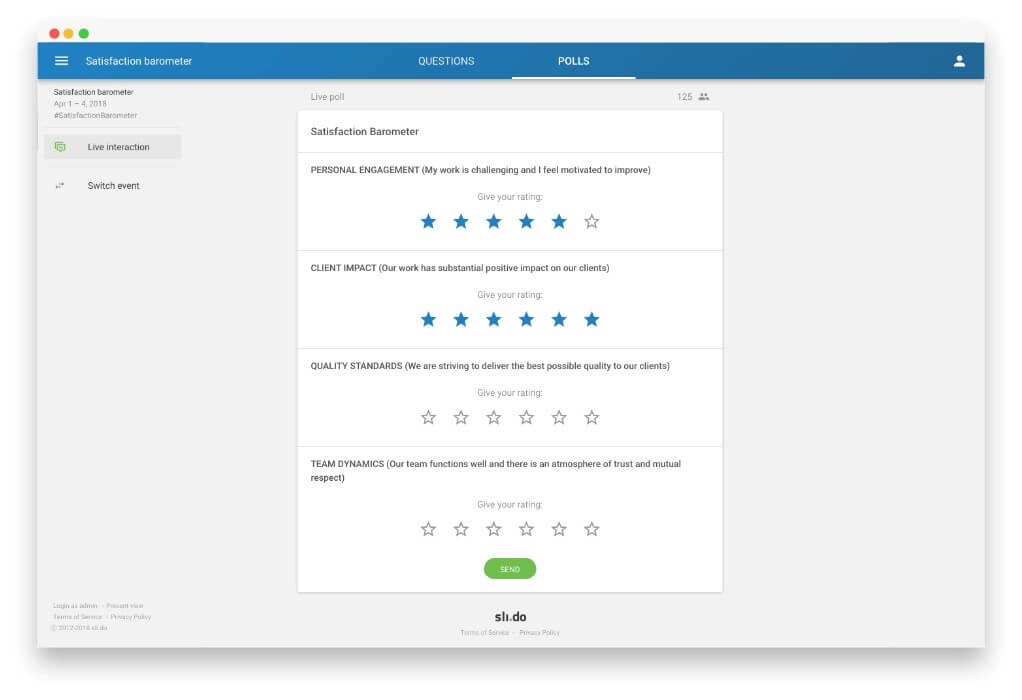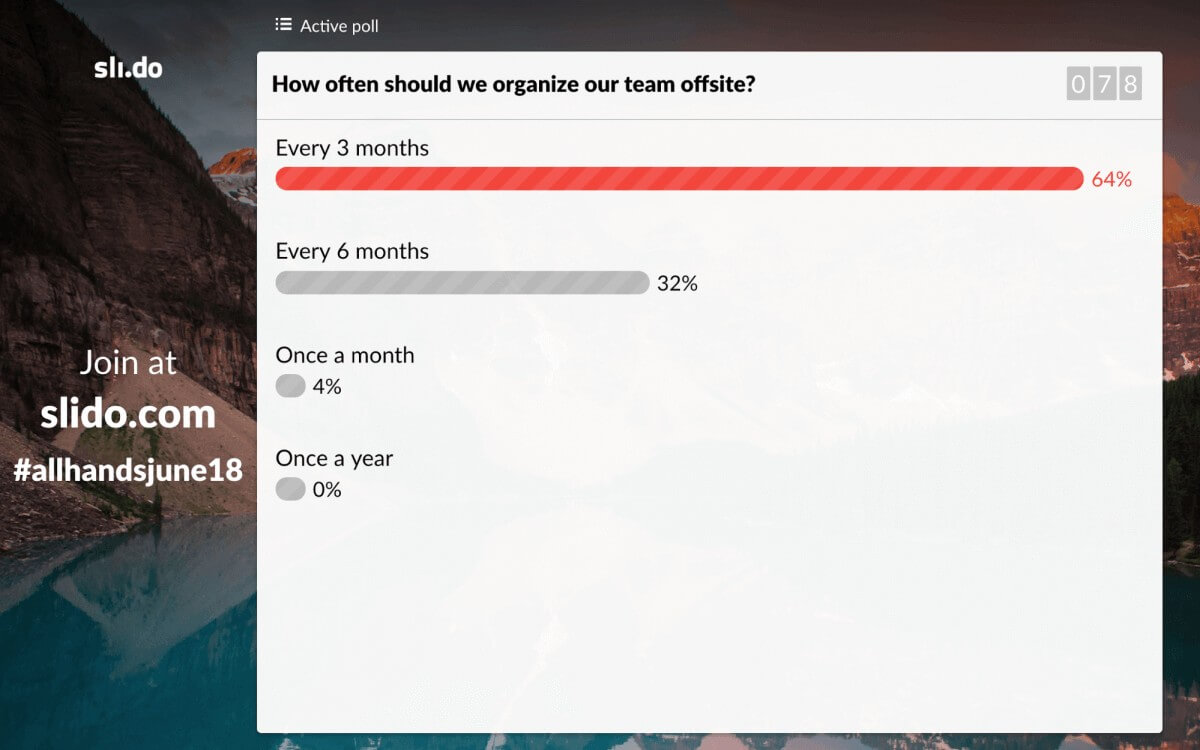If you want the most critical issues and innovative ideas to come to the surface, don’t wait for your employees to come to you. People need encouragement to say what’s on their minds. Be the first to ask them what they think and consult them regularly to foster open culture and fuel your company’s growth.
Here are three main ways in which you can collect employee feedback with live polls, inspired by how we do it at Slido.
1. Monthly employee satisfaction barometer
Running a regular all-company satisfaction barometer is a great way to keep track of how employees feel. It will help you uncover and address critical issues and track improvements.
Create a survey with questions about personal excitement, quality standards, and learning and development. Include an open-text poll where you allow people to elaborate on what they think should improve.

Share a link to the survey via your communication channels and collect responses in advance of the meeting. A week before our monthly all-hands meeting, we share a permanent link to the survey with all our employees in a Slack channel.
Extra tip: To get the most out of this exercise, give people a few reminders to submit responses.
Once you’ve collected responses, make sure you comment on the results when you present them to the team. Addressing the underlying issues will take you a long way toward creating a transparent work culture based on mutual trust.
Example poll questions that you can use:
Rating polls (Scale of 1-6, where 1 = the least, 6 = the most):
- Personal engagement: My work is challenging and I feel motivated to improve.
- Client impact: Our work has a substantial positive impact on our clients.
- Quality standards: We are striving to deliver the best possible quality to our clients.
- Team dynamics: Our team functions well and there is an atmosphere of trust and mutual respect.
- Team roles: We are all perfectly clear about our roles, which makes us more effective.
- Team productivity: We spend our time efficiently and our meetings are productive and collaborative.
- Learning & development: I’m satisfied with my personal growth and development.
- Timely feedback: I’m getting timely and constructive feedback that helps me improve.
- Sense of belonging: I feel that I’m an important part of the team.
Open text poll:
- What would make your work easier?
2. Retrospective session
We collect project-specific feedback by running regular dedicated retrospective sessions. At Slido, we use this format across different teams to evaluate projects and how our teams work during a set period.
Create a survey with a series of polls to review a set time period. Use a rating poll to find out people’s overall feelings about how things went in the given time period. Set up open text polls to find out what went well, what could be improved, and what people learned.
Collecting people’s input in advance will save you some valuable discussion time. Alternatively, you can get people to share their thoughts in real-time once everyone is in the room.
Extra tip: Include one open text field where you can give people a chance to bring up a topic they’d like to discuss.
Example poll questions that you can use:
Rating poll:
- How do you rate the past month?
Open text polls:
- What went well?
- What can we improve?
- What did you learn?
- Anything you’d like to discuss?

3. Instant feedback
The third approach is collecting insights from the team in real-time. It can help you make immediate improvements based on the employees’ inputs, e.g., how to fix your meetings, improve client offices or resolve operational issues.
We collect these 5 types of instant feedback from our team:
Icebreaker (or “feedforward”): Collect views at the start of your meeting to find out people’s expectations and tailor the content to your audience. For instance, ask what topics people want to focus on or what they want to learn.
Examples:
- What do you expect from this meeting? (Open text poll)
- What would you like to learn today? (Word cloud poll)
Brainstorming ideas: Collect ideas from the team about a project, to solve a challenge, or to improve existing practices. For instance, gather ideas about how to fix your meetings or office space.
Examples:
- What would you do to make our all-hands meetings more effective? (Open text poll)
- What can we do to improve the meeting experience for our remote colleagues? (Open text poll)
Collaborative decision-making: Involve team members in collaborative decision-making to make the process more democratic. It’s an easy check of where people stand on an issue. For instance, collect feedback on operational matters during an all-hands meeting.
Examples:
- How often should we organize our team offsite? (Multiple choice poll)
- Should we continue having the all-company Monday morning meetings? (Multiple choice poll)

Alignment with strategy and goals: Get the team’s instant feedback on the strategy and goals that you presented during a meeting.
Examples:
- Which of these should be our top priority for Q1? (Multiple choice poll)
- Overall, to what extent do you agree that these are the right goals? (Rating poll, scale 1-10)
- Is there anything we’ve missed? (Open text poll)
After-event feedback: Collect views at the end of a meeting or event to see how people found it. For example, ask how useful the session was or if you missed anything. Just make sure you implement people’s feedback in the follow-up sessions.
Examples:
- How useful did you find this session? (Rating poll, scale 1-10)
- Is there anything you would improve? (Open text poll)
But it’s not just about collecting feedback. Once you have it, it’s crucial to review, respond and act upon it. Implementing the suggestions and ideas from your team will make people feel more valued and show them you value their contributions.
Wrap up
Employee feedback is one of the most effective tools for CEOs, project managers, and team leads to learn about the critical issues in the company. Invite people to contribute their thoughts actively, consult them on key decisions, and use their insights to make improvements in projects or practices. Getting employees to say what’s on their minds and responding to their feedback will take you a long way toward creating an open and transparent culture in your team.




